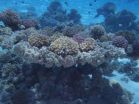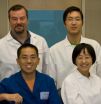(Press-News.org) Every taxonomist has calculated the number of existing species within their specialty and estimated the number that remain to be discovered, both through statistical models as based on the experience of each expert. According to Enrique Macpherson, researcher at the Center for Advanced Studies of Blanes (CEAB-CSIC, Spain), who has participated in the study: "Bringing together the leading taxonomists around the world to pool their information has been the great merit of this research".
The statistical prediction is based on the rate of description for new species in recent decades. The results show that the total number of marine species would be about 540.000. However, this number ranges from 320.000 to 760.000.
Meanwhile, the experts have made another estimation based on their experience and on a projection of the number of species found in the sampled areas. According to this prediction, the number of species ranges from 704.000 to 972.000. According to Xabier Turon, who also works as a researcher at the Center for Advanced Studies of Blanes (CEAB-CSIC): "the calculations for both methods yield figures with the same order of magnitude, which confirms that we know about one third of the species".
All the information pooled by the experts show that just 230.00 species are correctly described. In fact, researchers found about 170.000 cases of synonymy among previously known species. That is, one single species described under two (or more) different names.
Among the order, for instance, of cetaceans (Cetacea), researchers have found that there are 1.271 different names applied to just 87 species. CSIC researcher Damia Jaume, from the Mediterranean Institute for Advanced Studies (IMEDEA, CSIC-UIB) and also involved in the study, states: "the best known is the species, and its greater size and commercial interest, the most common is synonymy".
Of the roughly 230.00 marine species known, about 200.000 belong to the kingdom Animalia; 7.600 to Plantae; 19.500 to Chromista; 550 to Protista; and 1.050 to Fungi. The research has only counted with eukaryote organisms, i.e. those whose genetic information is enclosed in a cell nucleus, which has left out bacteria, viruses, and archaea.
What remains to be known
The research data suggest that there are still about two-thirds of marine species to be described, most of which would already be inventoried. Although most of the ocean has not been sampled, Macpherson states that "marine environments are less diverse and have very limiting factors such as light, which homogenizes the species that inhabit them. Thus, it is to be expected that the oceanic diversity is less than terrestrial diversity".
Although there is no consensus yet on the number of species that inhabit the earth's surface, this figure could be about 10 higher than the aquatic biodiversity.
CSIC researcher thinks that "maybe in a century's time, all marine species have been able to be described. However, the most we know, the most we can assure the exact number of aquatic biodiversity".
INFORMATION:
The research was led by the Flanders Marine Institute (Belgium) and the University of Auckland (New Zealand), and they have coordinated the activity of other 144 institutions.
The information compiled by researchers is available in an open access log through the website http://www.marinespecies.org
About one million species inhabit the ocean
Different marine eukaryote organisms could reach up to a number of 972.000. CSIC has participated in this international research, conducted by 270 taxonomists from 32 countries. The current number of marine species identified is roughly 230.000
2012-11-15
ELSE PRESS RELEASES FROM THIS DATE:
Penn study decodes molecular mechanisms underlying stem cell reprogramming
2012-11-15
PHILADELPHIA – Fifty years ago, British researcher John Gurdon demonstrated that genetic material from non-reproductive, or somatic, cells could be reprogrammed into an embryonic state when transferred into an egg. In 2006, Kyoto University researcher Shinya Yamanaka expanded on those findings by expressing four proteins in mouse somatic cells to rewind their genetic clocks, converting them into embryonic-like stem cells called induced pluripotent stem cells, or iPS cells.
In early October, Gurdon and Yamanaka were awarded the 2012 Nobel Prize in Physiology or Medicine ...
Early 50s may be key time to reach baby boomers with health messages
2012-11-15
COLUMBUS, Ohio -- For baby boomers, the peak interest in health issues comes at about age 51, with a second peak coming near age 65, according to a new study.
The results may help doctors and other professionals target this generation with health messages at a time when they are most receptive to hearing them, the researchers said.
The study, based on a survey of Americans age 45 to 65, showed that people in their late 40s had the lowest levels of interest in health issues. Interest rose quickly, however, and peaked in the early 50s, then dropped slightly and plateaued ...
Feinstein Institute researchers discover plant derivative
2012-11-15
MANHASSET, NY – Researchers at The Feinstein Institute for Medical Research have discovered that tanshinones, which come from the plant Danshen and are highly valued in Chinese traditional medicine, protect against the life-threatening condition sepsis. The findings are published in the December issue of Biochemical Pharmacology.
Inflammation is necessary for maintaining good health – without inflammation, wounds and infections would never heal. However, persistent and constant inflammation can damage tissue and organs, and lead to diseases such as sepsis. Sepsis affects ...
Researchers tap into CO2 storage potential of mine waste
2012-11-15
VANCOUVER, CANADA, NOVEMBER 15, 2012 -- It's time to economically value the greenhouse gas-trapping potential of mine waste and start making money from it, says mining engineer and geologist Michael Hitch of the University of British Columbia (UBC).
Hitch studies the value of mine waste rock for its CO2-sequestration potential, or "SP." He says mining companies across Canada will, in future, be able to offset CO2 emissions with so-named "SP rock," and within 25 years could even be selling emissions credits.
Digging, trucking and processing make mining an energy-intensive ...
Eating more fish could reduce postpartum depression
2012-11-15
Low levels of omega-3 may be behind postpartum depression, according to a review lead by Gabriel Shapiro of the University of Montreal and the Research Centre at the Sainte-Justine Mother and Child Hospital. Women are at the highest risk of depression during their childbearing years, and the birth of a child may trigger a depressive episode in vulnerable women. Postpartum depression is associated with diminished maternal health as well as developmental and health problems for her child. "The literature shows that there could be a link between pregnancy, omega-3 and the ...
Family commitment blended with strong religion dampens civic participation, Baylor researcher finds
2012-11-15
Blending religion with familism — a strong commitment to lifelong marriage and childbearing — dampens secular civic participation, according to research by a Baylor University sociologist.
"Strong family and strong religion. What happens when they meet? Is that good for the larger society? It is not always as it seems," said Young-Il Kim, Ph.D., Postdoctoral Fellow in Baylor's Institute for Studies of Religion.
His study — "Bonding alone: Familism, religion and secular civic participation" — is published online in Social Science Research. The findings are based on analysis ...
New study finds milk-drinking kids reap physical benefits later in life
2012-11-15
Starting a milk drinking habit as a child can lead to lifelong benefits, even improving physical ability and balance in older age, according to new research. A new study published in Age & Aging found an increase of about one glass of milk a day as a child was linked to a 5% faster walking time and 25% lesser chance of poor balance in older age. The researchers suggest a "public health benefit of childhood milk intake on physical function in old age" – a finding that has huge potential for adults over 65, a population expected reach more than 70 million by the year 2030, ...
How 'black swans' and 'perfect storms' become lame excuses for bad risk management
2012-11-15
The terms "black swan" and "perfect storm" have become part of public vocabulary for describing disasters ranging from the 2008 meltdown in the financial sector to the terrorist attacks of September 11. But according to Elisabeth Paté-Cornell, a Stanford professor of management science and engineering, people in government and industry are using these terms too liberally in the aftermath of a disaster as an excuse for poor planning.
Her research, published in the November issue of the journal Risk Analysis, suggests that other fields could borrow risk analysis strategies ...
A new way of looking at Prader-Willi Syndrome
2012-11-15
An Australian study reveals that people with the rare genetic disorder known as Prader-Willi Syndrome may have an impaired autonomic nervous system. This discovery opens up a new way of looking at the insatiable appetite experienced by all sufferers, as well as their very high risk of cardiovascular disease.
The autonomic nervous system controls our inner organs, including our gut, heart, liver and blood vessels. It is a finely tuned, dynamic system, responding moment-by-moment to the body's needs.
Researchers from Sydney's Garvan Institute of Medical Research, including ...
Scientists show protein-making machinery can switch gears with a small structural change process, which may have implications for immunity and cancer therapy, compared to the movie The Transformers
2012-11-15
JUPITER, FL, November 15, 2012 – For the past several years, Min Guo, an assistant professor at The Scripps Research Institute, has focused on the intricate actions of an ancient family of catalytic enzymes that play a key role in translation, the process of producing proteins.
These complex enzymes are a group of fundamental molecules that make building blocks for protein production. Present in every cell, these enzymes—known as aminoacyl-transfer RNA synthetases (tRNA synthetases)—select the proper amino acid and assign them to transfer RNAs to make a protein in the ...
LAST 30 PRESS RELEASES:
Injectable breast ‘implant’ offers alternative to traditional surgeries
Neuroscientists devise formulas to measure multilingualism
New prostate cancer trial seeks to reduce toxicity without sacrificing efficacy
Geometry shapes life
A CRISPR screen reveals many previously unrecognized genes required for brain development and a new neurodevelopmental disorder
Hot flush treatment has anti-breast cancer activity, study finds
Securing AI systems against growing cybersecurity threats
Longest observation of an active solar region
Why nail-biting, procrastination and other self-sabotaging behaviors are rooted in survival instincts
Regional variations in mechanical properties of porcine leptomeninges
Artificial empathy in therapy and healthcare: advancements in interpersonal interaction technologies
Why some brains switch gears more efficiently than others
UVA’s Jundong Li wins ICDM’S 2025 Tao Li Award for data mining, machine learning
UVA’s low-power, high-performance computer power player Mircea Stan earns National Academy of Inventors fellowship
Not playing by the rules: USU researcher explores filamentous algae dynamics in rivers
Do our body clocks influence our risk of dementia?
Anthropologists offer new evidence of bipedalism in long-debated fossil discovery
Safer receipt paper from wood
Dosage-sensitive genes suggest no whole-genome duplications in ancestral angiosperm
First ancient human herpesvirus genomes document their deep history with humans
Why Some Bacteria Survive Antibiotics and How to Stop Them - New study reveals that bacteria can survive antibiotic treatment through two fundamentally different “shutdown modes”
UCLA study links scar healing to dangerous placenta condition
CHANGE-seq-BE finds off-target changes in the genome from base editors
The Journal of Nuclear Medicine Ahead-of-Print Tip Sheet: January 2, 2026
Delayed or absent first dose of measles, mumps, and rubella vaccination
Trends in US preterm birth rates by household income and race and ethnicity
Study identifies potential biomarker linked to progression and brain inflammation in multiple sclerosis
Many mothers in Norway do not show up for postnatal check-ups
Researchers want to find out why quick clay is so unstable
Superradiant spins show teamwork at the quantum scale
[Press-News.org] About one million species inhabit the oceanDifferent marine eukaryote organisms could reach up to a number of 972.000. CSIC has participated in this international research, conducted by 270 taxonomists from 32 countries. The current number of marine species identified is roughly 230.000


